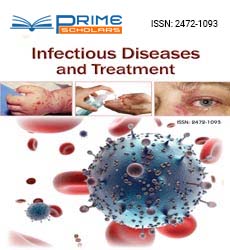Short Communication - (2022) Volume 8, Issue 5
The Role of Vectors in the Infectious Diseases
Diana Penny*
Department of Microbiology, University of California, USA
*Correspondence:
Diana Penny, Department of Microbiology, University of California,
USA,
Email:
Received: 02-May-2022, Manuscript No. ipjidt-22- 13636;
Editor assigned: 04-May-2022, Pre QC No. ipjidt-22- 13636 (PQ);
Reviewed: 18-May-2022, QC No. ipjidt-22- 13636;
Revised: 23-May-2022, Manuscript No. ipjidt-22- 13636 (R);
Published:
30-May-2022, DOI: 10.21767/ 2472-1093 - 8.5.28
Introduction
Vector-borne sicknesses are human diseases brought about by
parasites, infections and microorganisms that are sent by vectors.
Each year there are in excess of 700,000 passings from sicknesses,
for example, jungle fever, dengue, schistosomiasis, human African
trypanosomiasis, leishmaniasis, Chagas illness, yellow fever,
Japanese encephalitis and onchocerciasis.
Vectors can communicate irresistible infections either effectively
or passively: Biological vectors, for example, mosquitoes and
ticks might convey microorganisms that can increase inside their
bodies and be conveyed to new has, for the most part by gnawing.
Mechanical vectors, for example, flies can get irresistible specialists
outwardly of their bodies and send them through actual
contact.
In various European nations the infection has been separated in
mosquitoes, wild rodents, moving birds, hard ticks, ponies and
people. Since generally 80% of cases are asymptomatic, the pace
of West Nile infection diseases in people remains to a great extent
obscure and likely just a portion of the scourges with tens or
many West Nile fever cases have been reported [1].
Description
The weight of these illnesses is most elevated in tropical and
subtropical regions, and they lopsidedly influence the least fortunate
populaces. Beginning around 2014, significant flare-ups of
dengue, intestinal sickness, chikungunya, yellow fever and Zika
have burdened populaces, guaranteed lives, and overpowered
wellbeing frameworks in numerous nations. Different sicknesses,
for example, Chikungunya, leishmaniasis and lymphatic filariasis
cause ongoing misery, deep rooted grimness, incapacity and periodic
vilification.
Leishmaniasis is a protozoan parasitic contamination brought
about by Leishmania infantum that is communicated to individuals
through the nibble of a tainted female sandfly. Temperature impacts the gnawing action paces of the vector, diapause, and
development of the protozoan parasite in the vector. Tick-Borne
Encephalitis (TBE) is brought about by an arbovirus of the family
Flaviviridae and is sent by ticks (transcendently Ixodes ricinus)
that act both as vectors and as supplies. Like other vector-borne
infections, temperature speeds up the ticks’ formative cycle, egg
creation, populace thickness, and circulation [2].
Vector-borne infections address a wide assortment of biologic
frameworks. Vector control can decrease transmission of microorganisms
from arthropods; however the exercises included will
change as indicated by many elements from the vector species to
asset accessibility. At a general level, vector control can be partitioned
into individual security and local area insurance. A portion
of the intercessions are no different for each, however private insurance
lessens chomps on the distinctive individual, though local
area security accomplishes populace level consequences for
the vectors, either by diminishing their numbers or by shortening
their populace life span [3].
In light of the vector-borne illness articles evaluated, here obviously
environment is a significant geographic determinant of vectors,
however the information don’t convincingly show that new
climatic changes have brought about expanded sickness vector-
borne sickness occurrence on a dish European level. In any
case, the reports demonstrate that under environmental change
situations of the last many years ticks have logically spread into
higher scopes in Sweden and higher height in the Czech Republic
[4].
Conclusion
Admittance to water and sterilization is a vital considers infectious
prevention and end. WHO cooperates with a wide range
of government areas to further develop water capacity, disinfection,
in this manner assisting with controlling these illnesses at
the local area level?
Acknowledgement
None.
Conflict of Interest
The author declares there is no conflict of interest in publishing
this article.
REFERENCES
- Bates PA (2017) Transmission of leishmania metacyclic promastigotes by phlebotomine sand flies. Int J Parasitol 37(10):1097-106.
[Crossref] [Google Scholar]
- Qiu Y, Nakao R, Namangala B, Sugimoto C, et al. (2013) First genetic detection of coxiella burnetii in zambian livestock. Am J Trop Med Hyg 89(3): 518-519
[Crossref] [Google Scholar]
- Qiu Y, Nakao R, Hangombe BM, Sato K, Kajihara M, et al. (2019) Human borreliosis caused by a new world relapsing fever borrelia-like organism in the old world. Clin Infect Dis 69(1): 107-112.
[Crossref] [Google Scholar]
- Smith GL, Mackett M, Moss B (1983) Infectious vaccinia virus recombinants that express hepatitis B virus surface antigen. Nature 302(5908): 490-495.
[Crossref] [Google Scholar]
Citation: Penny D (2022) The Role of Vectors in the Infectious Diseases. J Infect Dis Treat. 8:28
Copyright: © Penny D. This is an open-access article distributed under the terms of the Creative Commons Attribution License,
which permits unrestricted use, distribution, and reproduction in any medium, provided the original author and source are
credited.
